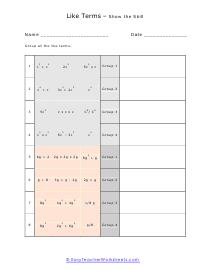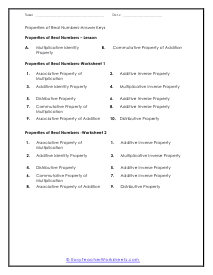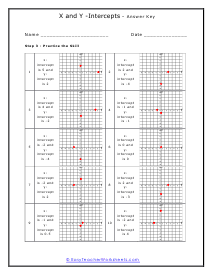The algebra worksheets found below cover a wide range of skills that start in late elementary school and pivot all the way to complex high school skills. The topics are arranged alphabetically to make them easier to find. While we would like to arrange them by difficulty (grade level) we find it paramount to allow teachers an easier way to find what they need because there is a great deal of carry over between levels. The biggest thing to remember, when working with algebra, is that the unknown symbols have very different values in different problems. The unknown symbols are always constant when in the same problem. For example, if you have a symbol x listed two or more times, x has the same value throughout the entire problem.
Algebra Worksheet Categories
Click any of the images or words below to print out those algebra sheets.

Absolute Value
We show students that this simply indicates how far away a value is from zero. It does not matter if the value is negative or positive, the numbers line shows that it just is an expression of how far to the left or right that we move.

Algebraic Fractions
These are simply fractions that have some form of variable either in the numerator or denominator of a fraction. The only known is that the variable can not be equal to zero.

Algebraic Manipulation
This is a series of lessons and worksheets that show you how to convert a math statement into an algebraic equation which can make it create a sense of being and quickly lead to a solution.

Associative Property
This simply says that no matter how you arrange a sum of three or more numbers the outcome will be the same. This also applies to multiplication. This will help us when solving equations and rearranging expressions.

Binary Operations
These types of operations just look at many different ways to combine two parts to create some form of whole value. N this case we look at various ways to combine two of the same types of objects.

Binomial Multiplication
We look at how to find the product between expressions that have two terms. Which often starts by using the FOIL method and then ending in combining like terms.

Combine Like Terms
This is the fundamental first step paradigm in all forms of algebra. Start by finding things that are alike and put them together over and over. This will lead you down the right path just about always.

Distributive Property
This is literally one of the most used and often cited properties in math. If you were to follow it you would multiply each addend found within parentheses by themselves and then just sum up the left products.

Equations With Radicals
Your goal here is to get that radical expression all by itself. This will help you when solving all types of higher level algebraic equations.

Exponential Growth
We look at how things almost virally increase in value and continue up the curve. This follows a regularly scheduled interval. This is commonly used in financial markets and the scientific community.

Factorial Notation
This soundly says to multiply all the numbers you find down from the number that we point out.

Finding the X and Y Intercepts
This helps you determine where a line or an equation of a line passes over the x or y-axis on a graph.

Function Tables
This is a data table that explores the relationship between input and output values based on a system. We will show you how to master these systems.

Irrational Numbers
For those times when you have a real number that not matter how hard you try, you cannot write it as a simple fraction.

Linear Systems (Algebraic Solutions)
These looks at equations that are poised with two variables. We show you how to solving them by graphing, using substitution and/or the elimination method.


Modeling Linear Equations
When build these by first identifying the slopes and the locating the intercept, which just require you to set their values to zero.

(Cyclic) Nature of the Powers of i
The mystical imaginary unit (i) follows a pattern when raised in power. We show you how to use this pattern to your advantage.

Properties of Real Numbers
We look at all the main properties: associative, closure, commutative, distributive, identity, inverses, and zeroes.

Proportional Relationships
We look for consistent ratios to form a relationship. They can also share the same rate of change.

Radical Operations
This skill helps us learn how to simplify and solve radical equations and expressions.

Set Builder and Interval Notation
We look at several different ways to notate data and arrange it in a way to make more sense of it for your data analysis.

Simplifying Algebraic Fractions
Make sure you understand how to find factors before you get into this section. I sometimes see students get too deep with this topic without having al the background that is needed.

Simplifying Radicals
We walk you through our four-step model for solving these. Make sure you fully understand prime factorization before you dive into this section.

Simultaneous Equations
We look at two equations that are missing all the same things and need to work on together.

Simplifying Powers
The easiest way to handle this is multiply any exponents that share the same base.

Slope Intercept Form
This is a very trendy way to form a straight line. It is also one of the easiest. Once you understand the components of y= mx + b it is pretty simple.


Slope of Parallel and Perpendicular Lines
What makes two lines parallel is that they are not located on the same line but have the same slope. Perpendicular lines are the negative reciprocals to one another.

Solving Linear Equations
The goal here is to find the value for the variables that makes the equation true.


Squares and Square Roots
It's funny how we work on these two together since they are inverses and cancel on another out.

Undefined Algebraic Fractions
We look at different ways to take the legs out from under the fractions that we come across.

Variables on Both Sides
We show you how to isolate each of the variables and then plug them back into to make sense of it all. This helps you learn how to quickly manipulate any equation.

Writing Numerical Expressions
We show you how to identify all the known and unknown parts of a well thought out equation. You are given a sentence and asked to generate your own equation based on it.

X and Y Intercepts
This is where the line crosses each axis. If you know both of them, you know enough about the line to model an equation for it.
What is Algebra?
Algebra is a powerful tool that allows us to solve problems that would be impossible to solve without it. It is the mathematics of equations and variables, which is why it is essential to science and engineering. Algebra is also the mathematics of functions and graphing, making it essential to economics and business.
Algebra is the fundamental approach to critical thinking skills. Engineers spend their entire living in a world of problems. They are taught to start by approaching a successful outcome by thinking in and algebraic manner. This starts by asking ourselves what do we know? Secondly, what do we not know? This leads us to determine a procedure to jump from problem to solution. This can be used to determine which product offers the best price. It can also help us analyze complex situations that we really are stumped with. Algebra is one of the core math skills used by successful people across the global economy. Basic word problems lead us to the fundamental use of algebra in trading goods and services. Algebra is based on the use of arithmetic (addition, subtraction, multiplication, and division). Algebra takes it a step further by adding an unknown usually denoted by the symbol x. The letter Xx is really popular. The symbol or variable is just a place holder telling us, that is what we are trying to find or determine. Almost all algebra involves equations. Equations are math statements that tell us that two things have the same value (are equal). The knowns help us find the unknowns. For example 8 + 3 = x or more advanced where x - 3 = 8.
The History Behind It
Algebra is a branch of mathematics that can be traced back to the ancient Babylonians and Egyptians. The earliest known algebraic text is the Al-Jabr wa'l-Muqabalahwa'l-Muqabalah (The Compendious Book on Calculation by Completion and Balancing), written by Muhammad ibn Mūsā al-Khwārizmī in the 9th century.
In the West, algebra was first studied by the Italian mathematician Leonardo Fibonacci (also known as Fibonacci of Pisa) in the 13th century. Fibonacci's book Liber Abaci introduced the Hindu-Arabic numeral system and algebra to Western Europe. Algebra continued to be developed by European mathematicians such as René Descartes, Blaise Pascal, and Pierre de Fermat in the 17th century.
Types of Algebra
There are many types of algebra, each with its specific rules and properties. The most common types are linear, abstract, and Boolean algebra.
Linear Form
Linear algebra studies mathematical problems that can be best explained in terms of linear equations. Linear equations involve only one variable and can be written as y = mx + b, where m is the slope of the line and b is the y-intercept. This type of math is used to solve problems involving lines, such as finding the equation of a line that passes through two points.
Abstract
Abstract algebra studies mathematical problems that can be best explained in terms of algebraic structures. Algebraic structures include groups, rings, and fields. Groups are sets of objects that can be combined using a binary operation, such as addition or multiplication. Rings are similar to groups, but they also have a second binary operation, called subtraction, which is used to cancel out the effects of the first binary operation. Fields are sets of objects that can be combined together using both addition and multiplication, such as the set of real numbers.
Boolean
Boolean algebra studies mathematical problems that can be best explained in terms of logical operations. Logical operations take one or more boolean values (true or false) as input and produce a boolean value as output. The most common logical operations are AND, OR, and NOT. This type of math is often used to solve logic problems, such as determining whether a given statement is true or false.
The Applications
Algebra is used to solve problems in a variety of fields. This form of math focuses on the uses and understand of equations and variables, which is used to solve problems in various fields. It can be applied to solving equations, graphing functions, manipulating polynomials, and much more.
In physics, algebra is used to solve problems involving motion and energy. In chemistry, it is used to balance equations and calculate the properties of substances. In engineering, it is used to design and analyze structures. Algebra is also used in business and economics to solve money and investment problems.
Wrapping Up
Algebra is a powerful problem-solving tool that you can use in many different fields. By understanding the principles of this math, we can solve problems more efficiently and effectively. We hope you have found this introduction to algebra helpful and informative. If you are looking for more ways to improve your math skills, please check out our other blog posts or visit our website. Thanks for reading!


